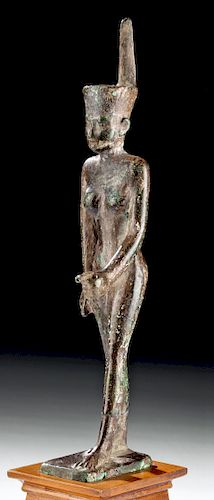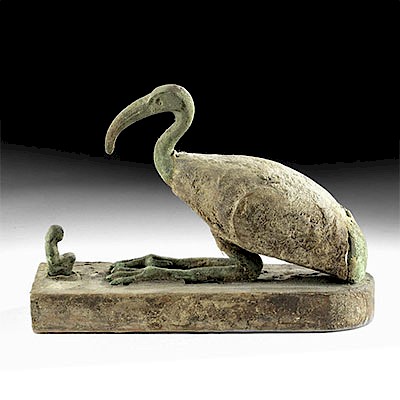Egyptian Bronze Striding Figure of Neith, ex-Mitry
Lot 3
About Seller
Artemis Fine Arts
686 S Taylor Ave, Ste 106
Louisville, CO 80027
United States
Selling antiquities, ancient and ethnographic art online since 1993, Artemis Gallery specializes in Classical Antiquities (Egyptian, Greek, Roman, Near Eastern), Asian, Pre-Columbian, African / Tribal / Oceanographic art. Our extensive inventory includes pottery, stone, metal, wood, glass and textil...Read more
Estimate:
$12,000 - $18,000
Absentee vs Live bid
Two ways to bid:
- Leave a max absentee bid and the platform will bid on your behalf up to your maximum bid during the live auction.
- Bid live during the auction and your bids will be submitted real-time to the auctioneer.
Bid Increments
| Price | Bid Increment |
|---|---|
| $0 | $25 |
| $300 | $50 |
| $1,000 | $100 |
| $2,000 | $250 |
| $5,000 | $500 |
| $10,000 | $1,000 |
| $20,000 | $2,500 |
| $50,000 | $5,000 |
| $100,000 | $10,000 |
| $200,000 | $20,000 |
About Auction
By Artemis Fine Arts
Oct 31, 2019
Set Reminder
2019-10-31 10:00:00
2019-10-31 10:00:00
America/New_York
Bidsquare
Bidsquare : Fine Antiquities, Asian, Ethnographic Art
https://www.bidsquare.com/auctions/artemis-gallery/fine-antiquities-asian-ethnographic-art-4581
Our Halloween Day auction features classical antiquities, ancient and ethnographic art from cultures encompassing the globe, plus fine art. Artemis Fine Arts info@artemisfinearts.com
Our Halloween Day auction features classical antiquities, ancient and ethnographic art from cultures encompassing the globe, plus fine art. Artemis Fine Arts info@artemisfinearts.com
- Lot Description
Egyptian, Late Period, 26th Dynasty, ca. 664 BCE to 525 BCE. A solid cast bronze figure of Neith (also Nit, Net, or Neit), the goddess of war, protector of hunters, and patron deity of Sais, in the Western Nile Delta. Neith, among the oldest of Egyptian deities, is depicted striding with her left leg advanced, wearing the Red Crown of Lower Egypt and a long closely fitting sheath - her right arm and fisted hand held tightly at her side, her left arm extended frontward. Assuming this striding pose with her left foot and arm advanced, she most likely once held a was-sceptre (symbolic of power and rule) and an ankh (symbol of life) in her hands. The figure stands upon an integral rectangular plinth with an integral peg beneath that fits into the wooden stand. A striking statue, replete with an impressive form as well as many layers of meaning - for further understanding of Neith's symbolism, please read the extended description below. Size: 7.75" H (19.7 cm); 9.25" H (23.5 cm) on included custom stand.
Neith was an Egyptian goddess of war and of hunting with cult centers in Sais (Delta) and Asyut (Middle Egypt). Her first appearance in Egyptian religion was rather early; scholars know that he symbol appears on stelae from the first dynasty. Her name was used for several royal names from this period as well.
As a goddess of war she assisted the pharaoh during his battles, and was said to "open the way" for him, a function she had in common with Wepwawet. This led to her becoming a goddess who gave protection, as well as one of a group of gods who helped the deceased. Together with Isis, Nephthys, and Serket she offered protection to the sarcophagus (known from Old Kingdom Pyramid Texts) and to the canopic chest containing the internal organs which had been removed during mummification. More specifically she was linked to Duamutef, one of the children of Horus, who watched over the stomach of the deceased.
Neith was also associated with weaving and was believed to be the one who wove the bandages of the mummy. This understanding as the goddess of weaving was extrapolated to protector of women as well as marriage.
The goddess was also associated with the Nile River (sometimes referred to as the mother of the crocodile god Sobek) and by extension was regarded as the personification of the primeval waters of creation. In addition, Neith was identified with the goddess Mehetweret ("The Great Flood") and also linked to Khnum as his wife and as the source of the Nile. Neith and Khnum were seen as creator gods in the temple of Esna and even visualized together as one androgynous creator god.
See a bronze figure of Neith at the British Museum - https://www.britishmuseum.org/research/collection_online/collection_object_details.aspx?objectId=122705&partId=1&place=39821&plaA=39821-3-2&page=1
See another bronze statue of Neith at the Louvre, Paris - http://cartelen.louvre.fr/cartelen/visite?srv=car_not_frame&idNotice=19775
Provenance: private Orange County, California, USA collection; ex-Phillip Mitry collection, noted dealer in Cairo, Egypt until about 1951 when he emigrated to the United States
All items legal to buy/sell under U.S. Statute covering cultural patrimony Code 2600, CHAPTER 14, and are guaranteed to be as described or your money back.
A Certificate of Authenticity will accompany all winning bids.
We ship worldwide and handle all shipping in-house for your convenience.
#148211Missing attributes once held in hands. Normal surface wear commensurate with age. Gorgeous green patina with areas of aqua patina as well.Condition
- Shipping Info
-
All shipping is handled in-house for your convenience. Your invoice from Artemis Gallery will include shipping calculation instructions. If in doubt, please inquire BEFORE bidding for estimated shipping costs for individual items.
-
- Buyer's Premium



 EUR
EUR CAD
CAD AUD
AUD GBP
GBP MXN
MXN HKD
HKD CNY
CNY MYR
MYR SEK
SEK SGD
SGD CHF
CHF THB
THB














